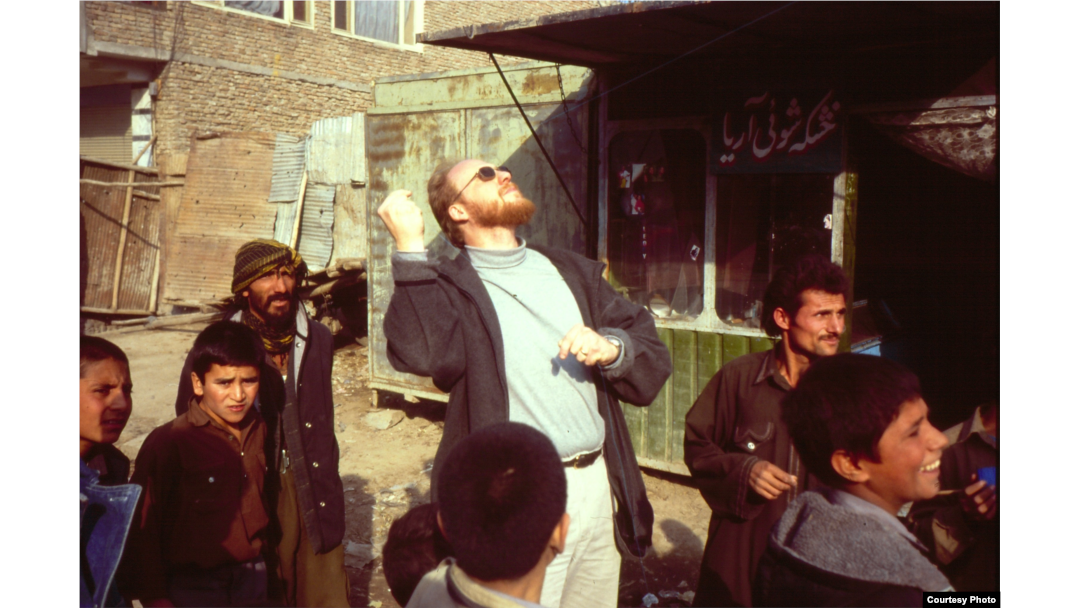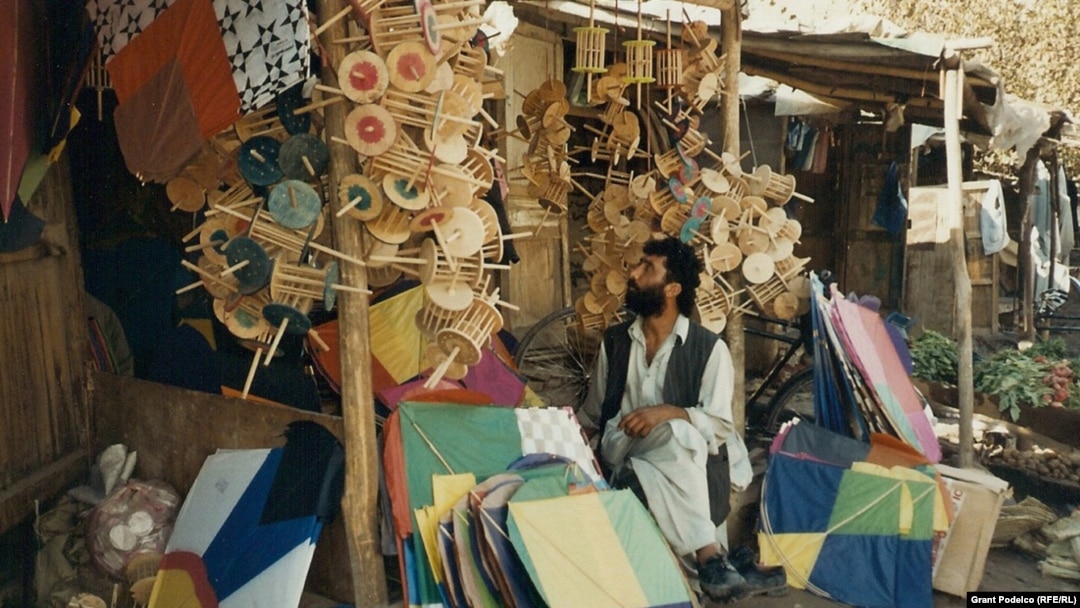KABUL -- It is a sunny day in Kabul, and the fighting is fierce.
This is a battle for control of the skies above the old city -- not between flying machines made of metal and rivets, but between delicate airborne art constructed from paper and string.
Afghans have elevated kite flying -- or "gudiparan bazi" -- to an art form, and one of its chief attractions is kite fighting.
To the first-time visitor, the skies above Kabul appear to be filled with fluttering birds or pieces of paper caught in the wind. A closer look reveals hundreds of brightly colored kites soaring high into the air.
The Taliban regime banned hobbies such as kite flying and bird keeping, in the belief that such pastimes were un-Islamic.
'They Would Beat You'
Karim is 12 years old and is helping his friend Muhasel fly a kite. He recalls what the Taliban would do if they caught someone flying a kite.
"During the Taliban, kite flying was not allowed. If you flew a kite, [the Taliban] would beat you and would break the spool and tear the kite up. Even if you had a pigeon in your hand, or any other birds, they would beat you and make it go free."
The fall of the Taliban in the capital one year ago (13 November), however, meant that Afghans could again fly kites without fear of punishment. Many Afghans have returned to the pastime with a vengeance.

The author tries his hand at kite flying in Kabul.
Kite flying is a two-person affair. One person, the "charka gir," holds the wooden spool around which the wire, or "tar," is wound. The second person -- called the "gudiparan baz," or kite flyer -- actually controls the movement of the kite in the air.
In Afghanistan, wherever there are kites, there is kite fighting. During the fight, or "jang," two kites are flown close to one another, often at great heights. The object is to use the wire of your kite to cut the wire of your opponent's kite and set it free.
Twenty-five-year-old Muhasel stands on the shaky roof of his small videocassette shop in southeastern Kabul, engaged in a kite fight with an unseen opponent elsewhere in the neighborhood. He explains what appeals to him about gudiparan bazi.
"I enjoy [flying kites] because I'm interested in it. When I see people are flying kites, then I buy a kite to fly and fight with the other kites. I enjoy it very much if my kite can cut off the other kite and make it go free. But if my kite gets cut free, then I buy another to fight with. If, for example, during the kite fighting I'm running out of wire, then there is nothing else to do but to cut the wire off the spool and let it go free in order to beat my opponent. And he, too, has to let his wire go until his kite goes free."
'Free And Legal'
Everything in Afghan kite fighting depends on the quality of the wire and how it is prepared. First, glass is finely ground and combined with an adhesive mixture to make a thick paste. The wire is then coated with this paste to make it strong and sharp. After it is dry, the wire is wound around the spool. Kite fighters often wrap a piece of leather around their fingers to protect themselves from the taut wire, which can cut to the bone.
When an opponent's kite is cut free, it flutters like a colorful, dying bird into the far reaches of the city. Such kites are said to be "azadi rawest," or "free and legal," and can be retrieved by neighborhood children to fly another day. Each neighborhood crowns its own "sharti," or kite-fighting champion.
Kabul is filled with shops selling all manner of kite paraphernalia. Twenty-six-year-old Jawid runs such a shop in the Shur Bazaar, the kite-selling market in old Kabul.
"People have been flying kites [in Afghanistan] for more than 100 years. It was banned during the Taliban. They would say that kite flying was illegal. We sell and buy from 500 to 2,000 kites every day in our shop. The Taliban banned this and used to beat children when they flew kites. Long ago, kite flying was part of our national games, and my father won a trophy 25 years ago during [former Afghan President Mohammad] Daud Khan's time."
Jawid gives a tour of his shop, pointing out the spools, the various lengths of wire, and the bright kites themselves, in many different sizes, or "parcha."
"This is a spool. Those are smaller ones for kids -- about 100 [meters] up to 500 meters in length. Those are 4,000- to 5,000-meter spools that are used by adults. These are for kids. These are different kites. For example, this is four parcha [having four parts]. There is five parcha. And that is seven parcha. That is half parcha (one of the smallest). That is farfara, which is made of plastic. And that is eight parcha (the largest)."
Done In Secret
The kites cost from 2,000 afghanis -- just a few cents -- for tiny children's kites no bigger than a magazine, to 100,000 afghanis -- less than $2 -- for large kites usually handled only by the most experienced flyers.
Jawid says he still sold kites during the days of the Taliban, but that everywhere it was done in secret.
"During the Taliban, we were doing our business here, but if they found out, they would come and destroy our kites, spools, and other stuff, as they did many times. They burned our kites and other stuff, asking who the owner was. But we could not say anything, because if they knew, they would imprison us in Amribelmaroof [prison]."
Winter is one of the most popular times for kite flying in Afghanistan. The winds are strong, and schools are closed because of the cold weather.
While it brings mostly smiles, kite flying is also dangerous. Many people are injured when they fall from roofs chasing free kites or when they lose concentration during a heated battle.
Thirty-six-year-old Sharif is flying a kite beside the dry, trash-filled bed of the Kabul River in central Kabul. He says he's been flying kites for about 20 years, always on Fridays.
Sharif recalls the glory days of kite flying in Kabul, before the Taliban.
"Before the Taliban, people used to fly kites in a place called Chaman-i-Babrak [in northern Kabul], and kite flying competitions were held there. Kids, young people, and older people from all over Afghanistan and Kabul City would gather there. They used to lay wagers on fighting kites."
Sharif smiles. He wants to get back to his kite flying. There is a battle to be won.


